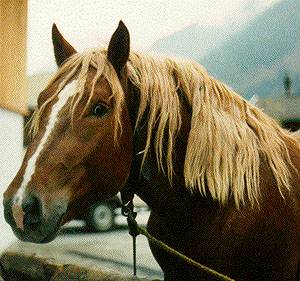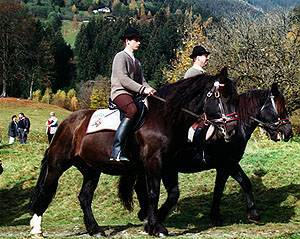Noric Horses
 Also Known By: Noriker or Norisches Kaltbult (German), Pinzgauer.
Also Known By: Noriker or Norisches Kaltbult (German), Pinzgauer.
The Noric horse, also known as the Noriker, has been bred for approximately 2000 years in the alpine piedmount of Austria. The recent status and census of this rare domestic animal shows the serious position in conservational breeding.
Archeological sites dating back to around 600 BC provide evidence that Celts in the alpine region owned horses, in some cases even spotted horses. After the province "Noricum" was founded by the Romans on the territory of modern-day Austria, heavy breed Roman draught horses were introduced to Central Europe at the time of Christ's birth, giving rise to a new breed of horse. This breed owes its name to the former Roman province Noricum.
In the 8th century, under Charlemagne, the breeding of heavy stocks flourished. The first document stud farm for Noric horses was in SchloB Rief near Hallein in 1576. Horse breeding there was in the hands of the archbishops of Salzburg. The frescos of the famous "Pferdeschwamme" in the city of Salzburg portray stylized horses with roman-nosed heads and massive bodies- unmistakably cold-blooded or heavy horses. Many portrayals from that time show how popular unusually colored and patterned horses were, a trend that held until the turn of the 20th century.
The Salzburg archbishops continued to promote the breeding of these horses, even drawing up strict guidelines for breeding in the 17th century. These horses largely found use as ceremonial and parade horses, and colorful specimens were highly sought-after.
 The first inspection regulations for stallions were drafted in 1703. In the 18th century,
Noric horses became important as work animals in the agricultural sector. The farmers
soon realized, however, that those horses considered by the archbishops to be of a
better breed (i.e. those interbred with Neapolitan and Andalusian warm-blooded horses
to produce riding and carriage horses) were not optimal for work in alpine regions.
Preference was again given to the more common type of heavy work horses, which were
less temperamental in difficult terrain.
The first inspection regulations for stallions were drafted in 1703. In the 18th century,
Noric horses became important as work animals in the agricultural sector. The farmers
soon realized, however, that those horses considered by the archbishops to be of a
better breed (i.e. those interbred with Neapolitan and Andalusian warm-blooded horses
to produce riding and carriage horses) were not optimal for work in alpine regions.
Preference was again given to the more common type of heavy work horses, which were
less temperamental in difficult terrain.
With time, the landscape, climate, ground, and hard work on farms gave these horses the build and characteristics of a versatile cold-blooded breed. The result was the heavy alpine Noric, which ultimately served as a riding, carriage, and work horse for knights, farmers, and merchants in the Middle Ages.
As of 1820, after the secularization of this branch, the first state-owned stud farms were built in the province of Salzburg. The breeding of Noric horses experienced many ups and downs in the following years. Although a number of races such as Clydesdales, Belgians, Oldenburgs, Holsteins, Spaniards and Neapolitans were interbred, the primary effort was directed pure breeds. Burgundy stallions were often used due to a lack of studs.
In 1885 this led to new inspection regulations to counteract the interbreeding with other races. The underlying goal was to apply strict selection criteria in order to achieve a pure breed and improve the declining quality of the Noric horses.
Toward the end of the 19th century a registry of mares and stallions was established. By 1903, this included 135 stallions and 1081 mares. Branding was employed to clearly mark the horses. The height of this development was reached in the late 1920's, when the Bavarian and Austrian Noric breeders joined forces to define the breeding targets. The World War and the subsequent mechanization of agriculture and forestry led to a continuous reduction in the horse population. In the mid-1960s, however, renewed, led to a re-establishment of the breed. While most Norics were bay horses, interbreeding with Mediterranean races led to unusual coloration such as isabels, dappled horses, leopards and blue roans. This explains the brown, red, and roan colors.
The breeding of Austrian Noric is currently based on five blood lines: Volcano, Nero, Diamand, Schaunitz, Elmar . In the post-war years, the goal was a heavy breed, not all to large, low set, and sturdy work horse with optimal fundament. Half of these horses were bay horses, although chestnuts were also abundant. The leopards markings that characterized earlier Norics became rare.
Performance tests were introduced, but the number of Norics dropped rapidly in the 1960’s and 1970s from 34,510 to 9,599. Recent years have been marked by a slight increase and renewed interest in cold-blooded horses.
Measurements, weight, and other physical and biological properties of the Noric today represent the horse that to a high degree meets all requirements demanded of a modern commercial horse.
The Noric differs from other heavy or draft breeds in several ways. It has quality, nerves and personality, and it is a qualified work horse. Due to the rough environment and special requirements of use in forestry and as a draft and pack animal in the mountains, there was selection for contentedness, toughness, endurance, and tame character.
Not as heavy as the Percheron or Belgian, the Noric is best suited for work in the Alpine forest. Working with horses is not only more economical, at least in certain areas, but also more ecologically sound. Horses neither pollute the air nor damage trees and soil as heavy machinery does.
Norics are increasingly becoming sport horses and are being used both as driving and riding horses. This is also reflected in the trend away from the original heavy breed to a horse with a good gait combined with sense of balance, sure step, and climbing ability. Increased ecological awareness has promoted the use of Norics as work animals in alpine regions. In tourist regions they have also gained popularity as carriage and sled horses. Unfortunately, the fertility of this cold-blooded race is somewhat disappointing.
Currently, black horses, bay horses and chestnuts each make up about 90% of the Norics. The remaining 10% are leopards and roans.
Desired body measurements in stallions: at least 155 cm withers height, 23 to 25 cm cannon bone, and 205 to 215 cm chest girth.
Carriage driving courses, horse skidding courses, and the use of this breed as riding, driving, and work horses have increased the importance of Norics. The growing imports of spotted horses from the USA since the 1980s have rekindled interest in colorful Norics. These promising developments have increased the chances of preserving this cultural heritage in Austria.
References
Arbeitsgemeinschaft der norischen Pferdezuchtverbande Osterreichs, A-5751 Maishofen 96, Phone: 0 65 42 / 82 32
Hendricks, Bonnie L., International Encyclopedia of Horse Breeds, Univ of Oklahoma Press, 1995.
Mason, I.L. 1996. A World Dictionary of Livestock Breeds, Types and Varieties. Fourth Edition. C.A.B International. 273 pp.
Dr. Harald Schwammer. Vienna Zoo, Schoenbrunner tiergarten-GmbH.
